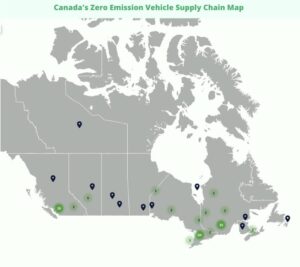The interactive map is a powerful resource for understanding the up to date status of Canada’s zero-emission vehicle industry

A new map of Canada’s zero-emission supply chain by Accelerate, Trillium Network for Advanced Manufacturing, NGen Canada and Electric Autonomy is giving a visual representation to the national growth, investments and talent clusters. Photo: Accelerate
The interactive map is a powerful resource for understanding the up-to-date status of Canada’s zero-emission vehicle industry
A new map of Canada’s zero-emission supply chain is giving a visual representation to the national growth, investments and talent clusters.
The ZEV Supply Chain Interactive Map is the result of a collaboration between Accelerate, Trillium Network for Advanced Manufacturing, NGen Canada and Electric Autonomy.
“The story we are telling though this map is one of a country building on our natural and industrial advantages. [Canada is] positioned to be a clear leader in the zero emission vehicle industry,” says Matthew Fortier, president and CEO of Accelerate, in a statement to Electric Autonomy.
“This is also a tool that will allow companies to find each other upstream and down and can lead to greater business-to-business collaboration.”
Visualizing growth
The ZEV map — posted here — reflects all the layers of Canada’s supply chain, encompassing mining activities to battery cell manufacturing and battery recycling to charging system manufacturing.
It tracks the evolution of Canada’s ZEV supply chain year-over-year since 2016. It gives a visualization of the “Zero to Hero” journey Canada is on, says Accelerate.
“We believe knowledge is power and we need to be able to tell the story that this is not simply about one or two plants. It’s about a historic opportunity for the sector and our economy,” says Moe Kabbara, vice president at Transition Accelerator and senior advisor to Accelerate, in an emailed statement to Electric Autonomy.
“Through the development of this interactive map, our aim is to provide the world with clear visibility into Canada’s wins in the emerging zero-emission vehicle supply chain.”
The growth seen in Canada as the federal and provincial governments have moved rapidly to onshore the ZEV supply chain is significant. Often referred to as “the opportunity of a generation,” the competition to secure ZEV supply chain investments worth tens of billions of dollars is fierce.
Volkswagen, Stellantis, Umicore, Lion Electric, LG Chem, Posco, General Motors and Ford are just a small selection of the marquis company names that have put a stake in Canada’s supply chain since 2016. But there remain many opportunities to attract more.
“Understanding the trajectory of Canada’s EV ecosystem is vital to understanding our competitive advantages as well as our gaps,” says Brendan Sweeney, managing director of Trillium Network for Advanced Manufacturing.
“This map provides a comprehensive tool to illustrate the progress that has been made over the past five years and will hopefully illustrate the progress that is being made today and in the future.”
Building out the map
The ZEV supply chain map will live as an evergreen resource, say Accelerate, Trillium and NGen.
“The electric vehicle sector is in the midst of a profound transformation,” explains John Laughlin, chief technology officer at NGen. “This interactive map not only aids companies in forging partnerships but will also support decision making around key economic policies and attracting potential international investments to Canada.”
In addition to regular updates on the industries and sectors already represented, the intention is to expand the supply chain components to include R&D and talent; power generation infrastructure, hydrogen fuel cell fuelling centres and, perhaps, even the carbon footprint of each supply chain component.
Companies wishing to appear on the map may contact [email protected].
“Our ultimate goal is to attract even more investments and foster the continued development of the ZEV sector, driving innovation, job creation, and increased economic activity across the whole country,” says Kabbara.
“By showcasing the key players, regional clusters, and investment trends, we hope to inspire increased confidence and strategic decision-making within the industry.”






